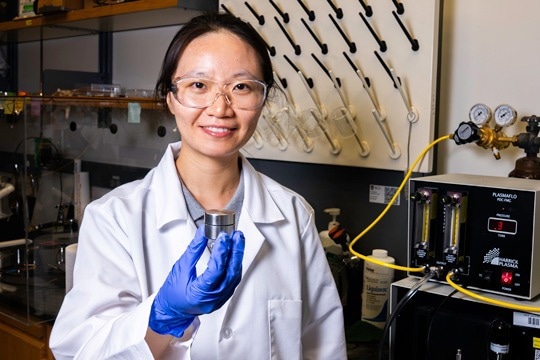Rice University engineers have produced containers that have the potential to keep volatile organic compounds (VOCs) from accumulating on the stored nanomaterials’ surfaces. The study was published in the American Chemical Society journal Nano Letters.
 Rice University Ph.D. student Zhen Liu and colleagues in the Department of Mechanical Engineering’s Preston Innovation Laboratory developed container technology that can prevent volatile organic compounds from coating the surface of stored objects for at least six weeks. Image Credit: Gustavo Raskosky/Rice University.
Rice University Ph.D. student Zhen Liu and colleagues in the Department of Mechanical Engineering’s Preston Innovation Laboratory developed container technology that can prevent volatile organic compounds from coating the surface of stored objects for at least six weeks. Image Credit: Gustavo Raskosky/Rice University.
The portable and cheap storage technology highlights a common concern faced by nanotechnology and material scientists.
VOCs are in the air that surrounds us every day. They cling to surfaces and form a coating, primarily of carbon. You can’t see these layers with the naked eye, but they form, often within minutes, on virtually any surface exposed to air.
Daniel Preston, Study Corresponding Author and Assistant Professor, Department of Mechanical Engineering, Rice University
VOCs are carbon-based molecules released from several common products, such as paints, cleaning fluids, and office and crafting supplies. In particularly high concentrations, they accumulate indoors. In addition, the thin layers of carbon gunk they deposit on surfaces can hamper processes of industrial nanofabrication, restrict the precision of microfluidic testing kits, and create confusion for researchers who perform fundamental research on surfaces.
To solve this issue, Ph.D. student and study lead author Zhen Liu, along with Preston and others from his laboratory, built a new kind of storage container that keeps objects clean. Experiments proved that her method efficiently limited surface contamination for a minimum of six weeks and could even clean VOC-deposited layers from earlier contaminated surfaces.
The technology depends on an ultraclean wall present inside the container. The interior wall’s surface is enhanced with small bumps and divots ranging in size between a few millionths and a few billionths of a meter. The nanoscopic and microscopic imperfections increase the surface area of the wall, which makes its metal atoms available to VOCs in air that is inside the containers when they are sealed.
“The texturing allows the internal container wall to act as a ‘sacrificial’ material,” Liu stated. “VOCs are pulled onto the surface of the container wall, which allows other objects stored inside to remain clean.”
She stated that employing a large precleaned surface to accumulate pollutants was suggested 50 years before but went largely overlooked. She and her co-workers improved on the notion with advanced methods of cleaning and nanotexturing surfaces. Through a series of experiments, they showed that their method did a better job of eliminating VOCs from coating the surfaces of stored materials than other methods, which include state-of-the-art vacuum desiccators and sealed Petri dishes.
Preston’s group built on its experiments, coming up with a theoretical model that precisely defined what was happening within the containers. Preston said the model will let them refine their designs and optimize system performance in the coming days.
The study was financially aided by Rice’s Shared Equipment Authority, the Rice University Academy of Fellows, the United States Coast Guard Advanced Education Program, and an Innovation in Buildings fellowship from the Department of Energy (DE-SC0014664).
Journal Reference:
Liu, Z., et al. (2023) Mitigating Contamination with Nanostructure-Enabled Ultraclean Storage. Nano Letters. doi.org/10.1021/acs.nanolett.3c00626.